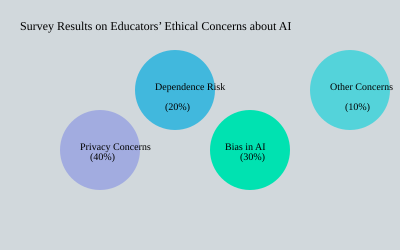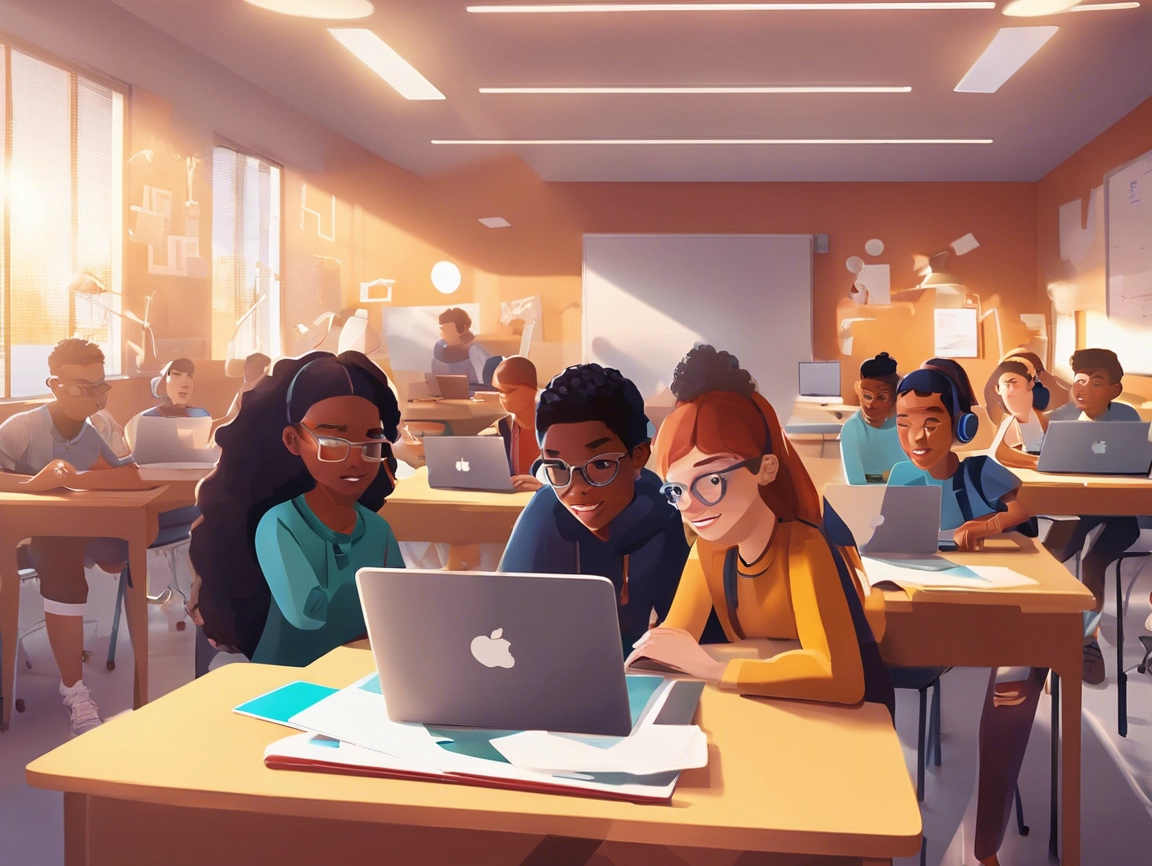Imagine a world where teachers can instantly generate comprehensive rubrics, lesson plans, and assessment tools, all at the click of a button. Welcome to the evolving realm of AI in education! With the rapid developments in generative AI, educators are now armed with unprecedented tools to enhance their teaching strategies. This blog delves into how AI is gripping the education sector by storm, the significance of prompt libraries, and why educators should embrace AI rather than shy away from it.
The Dawn of AI in Education
Overview of AI’s Emergence in Educational Contexts
Artificial Intelligence (AI) is reshaping education as we know it. It’s not merely a trend— it’s a revolutionary shift. Historically, education has seen tools evolve, from chalkboards to computers. But now, with tools like ChatGPT and Claude, educators face a new frontier.
Just as the internet changed everything in the late 1990s, AI is similarly sparking excitement today. Educators are discovering how AI can streamline lessons, create personalized learning paths, and assist with administrative tasks. Why? Because effective integration can enhance the learning experience.
Impact on Traditional Teaching Methods
AI challenges conventional approaches to teaching. Typically, educators used to handle everything manually. Now, they can delegate tasks to AI. For example, rubrics can be generated easily, which allows teachers more time to focus on their students. Imagine cutting down on paperwork while enhancing interaction with learners.
However, some educators remain skeptical or uninformed about how to weave AI into their teaching. Currently, only about 2% to 15% of educators use AI tools effectively. This gap calls for change and adaptation in pedagogical methodologies.
Examples of AI Tools Currently in Use
- ChatGPT: Ideal for generating lesson plans and aiding in student inquiries.
- Claude: Focuses on language analysis and comprehension.
- Gemini: Offers a multi-modal approach to learning, integrating different forms of media.
“AI is changing education faster than we ever anticipated, providing tools that were once dreams.” – Martin Fowler
Statistics on AI Adoption Rates
| Year | Adoption Rate (%) |
|---|---|
| 2020 | 10% |
| 2021 | 20% |
| 2022 | 35% |
| 2023 | 50% |
Trends in Educational Technology Sector
| Trend | Growth Rate (%) |
|---|---|
| AI Tools | 45% |
| Online Learning | 30% |
| Interactive Learning | 25% |
| VR/AR Techniques | 15% |

AI for education is shifting paradigms. It transforms how educators approach lessons, making learning more adaptable and personalized. This evolution is not merely about technology adoption but also about building a new framework in pedagogy.
Understanding Prompt Libraries: A Teacher’s Ally
In today’s fast-paced educational landscape, teachers often find themselves stretched thin. Enter prompt libraries. What exactly are they? Simply put, prompt libraries are collections of suggested prompts and questions aimed at enhancing classroom discussions and activities. They serve as essential tools, allowing educators to tap into AI-generated resources that can simplify lesson planning and provide creativity.
Benefits of Using Prompt Libraries in Lesson Planning
Integrating prompt libraries into lesson planning offers several key advantages:
- Time-Saving: Instead of starting from scratch, teachers can easily find and use pre-existing prompts.
- Enhanced Depth: AI-generated prompts often lead to richer classroom discussions.
- Adaptability: Educators can modify prompts to fit various topics and student needs.
As Amanda, the CEO of AI for Education, states, “I realized that we could spend time creating, or we could utilize these AI tools to enhance our efforts.” This perspective highlights the importance of leveraging technology to support education.
Tips for Integrating Prompt Libraries into Daily Teaching
How can teachers effectively use prompt libraries? Here are some practical tips:
- Choose Wisely: When selecting prompts, consider your lesson’s objectives. Not every prompt will be a fit.
- Encourage Student Participation:Allow students to brainstorm their prompts based on the library’s suggestions.
- Iterate and Improve: Continuously gather feedback from students to refine prompts and their use in future lessons.
The Role of Community Shares
One of the strengths of prompt libraries is the role of community shares. Teachers can create and share their prompts. This collaborative learning helps everyone grow. It fosters a supportive environment where educators can learn from one another.
Statistics at a Glance
Understanding the impact of prompt libraries is vital. Here’s a summary of relevant statistics:
| Statistic | Value |
|---|---|
| Number of teachers using prompt libraries since inception | Over 200,000 |
| Feedback statistics on user satisfaction | 85% satisfaction rate |

Prompt libraries are not just a trend; they are transforming the way teachers design lessons. By embracing these tools, educators can focus on what truly matters: engaging students and fostering a love for learning.
AI literacy: The New Literacy Skill of the Future
In an age driven by technology, AI literacy has emerged as an essential skill for both educators and students. Why is this necessary? The rapid advancements in artificial intelligence bring both opportunities and challenges. Failure to grasp these concepts may lead to students becoming passive consumers, rather than critical users, of technology. This is why the education community must prioritize AI literacy.
The Importance of AI Literacy in Modern Education
Jerry emphasizes,
“Teaching AI literacy is imperative to ensure students can navigate and utilize technology effectively in their future jobs.”
Understanding AI allows students to engage with the tools shaping their world. It’s about preparing them for a future where AI is ubiquitous. However, many educators express their concerns about AI as a challenge rather than an asset.
Strategies for Improving AI Literacy
- Training Workshops: Schools need to host workshops that focus on hands-on experiences with AI tools.
- Curriculum Integration: Teachers should integrate AI concepts into subjects already taught, making it a part of the learning journey.
- Providing Resources: Sharing resources like Amanda’s prompt library can help educators better understand AI.
Successful Workshops Improving AI Understanding
There have been notable workshops that significantly changed how educators engage with AI. These sessions aimed to educate teachers on utilizing AI effectively, demonstrating that proper understanding can transform their teaching methods. Jamie stated,
“AI demystifies the teaching process and re-engages educators.”
This highlights the positive impact of AI when properly understood.
| Workshop Results | Teacher Familiarity Survey (%) |
|---|---|
| Increased AI understanding post-training | Before: 5% | After: 50% |
| Improving engagement in AI tools | Before: 10% | After: 60% |
Here’s a visual representation of the improvement in AI understanding:

As schools aim to foster AI literacy, it becomes clear that understanding these tools can enrich the educational experience. It’s vital for educators to challenge misconceptions about AI. Embracing modern teaching practices is essential.
Navigating Challenges: Ethical Considerations in AI Adoption
The rapid evolution of AI in education raises numerous ethical considerations. Are these technologies really beneficial in our classrooms? Educators constantly find themselves caught in a crossfire of excitement and fear regarding AI tools.
Common Ethical Concerns with Educational AI
One major concern is privacy. As AI tools gather data, questions arise: Who owns this data? How is it used? Maintaining student confidentiality must remain a priority. Additionally, there’s apprehension over biases in algorithms, which may unintentionally favor certain groups while marginalizing others. This leads to an important question: How can educators ensure fair access to AI tools?
- Privacy Rights: Protecting students’ private information.
- Bias in AI: The risk of misrepresentation and unfair treatment.
- Dependence on Technology: Will students become reliant on AI for basic skills?
Addressing Fears Among Educators and Students
To combat these fears, schools must foster awareness. Clear communication about the potential of AI—paired with training—can help ease concerns. They should also create safe environments where educators can experiment with AI applications. By promoting open dialogue, teachers may better understand how to utilize these tools effectively.
Guidelines for Responsible AI Integration
Creating a framework for AI use in educational settings is essential. This process should include:
- Establishing clear ethical guidelines.
- Streamlining training programs for educators.
- Regularly reviewing AI integration outcomes.
“Ethics can’t be an afterthought in technology deployment; it’s the foundation we need to establish.” – Amanda.
Case Studies and Statistics
Learning from others is vital. Observing schools that have successfully implemented ethical AI practices provides a blueprint for action. Evaluating statistics also reveals the heart of educators’ uncertainty.
| Case Studies on Ethical AI Practices | Statistics on Teacher Concerns |
|---|---|
| School A: Established a technology committee for ethical AI use. | 70% of teachers express concerns over AI tool implementation. |
| School B: Provided training sessions focused on ethical guidelines. | 55% feel unprepared to use AI tools. |

By openly addressing fears and laying down robust ethical guidelines, educational institutions can make significant strides toward integrating AI responsibly. As Amanda rightly points out, ethics must come first in this modern technological landscape. For more insights, subscribe and engage with our community at Transcenders.app.
Conclusion: Embracing the Shift Towards AI-Driven Education
As the conversation surrounding Artificial Intelligence (AI) in education unfolds, it’s essential to reflect on the main ideas discussed. Throughout the blog, various influential figures highlighted how AI can serve as an invaluable partner in education, rather than a competitor. Amanda, the CEO of AI for Education, aptly pointed out,
“The key is not to fear AI but to understand how to leverage it for our students’ benefit.”
This perspective fosters a culture of collaboration and innovation in classrooms.
But what does the future hold for AI in education? The potential is enormous. Educational institutions must embrace AI tools and training to enhance teaching effectiveness. Amidst advances in technology, there remains hesitation among educators. The reality is many still struggle with misconceptions about AI. However, moving forward, educators need to view AI as a resource to ease their workload, not as a threat to their profession.
As AI continues to gain traction, consider these projected trends for AI usage in classroom settings over the next five years:
| Year | Projected AI Usage (%) |
|---|---|
| 2024 | 20% |
| 2025 | 35% |
| 2026 | 50% |
| 2027 | 65% |
| 2028 | 80% |

In closing, educators are encouraged to unlock the vast possibilities that AI offers. Explore the various tools available. Engage in AI training and workshops. This journey is not just about adopting new technologies, it’s about transforming how lessons are delivered, how students learn, and how educators interact with their classrooms.
As Amanda noted, adopting AI means gaining time back to build richer relationships with students. If educators can navigate this transition with the right framework and resources, the future presents endless opportunities. Finally, to stay updated and engage further in this transformative journey, consider visiting Transcenders.app for more resources and insights.
TL;DR: AI is revolutionizing education by providing teachers with tools like prompt libraries to enhance teaching effectiveness and streamline resource generation. This blog discusses practical tips to leverage these advancements in the classroom.
We appreciate LinkedUp: Breaking Boundaries in Education and Amanda Bickerstaff’s contributions. View it here: https://youtu.be/zDNUssI05do


